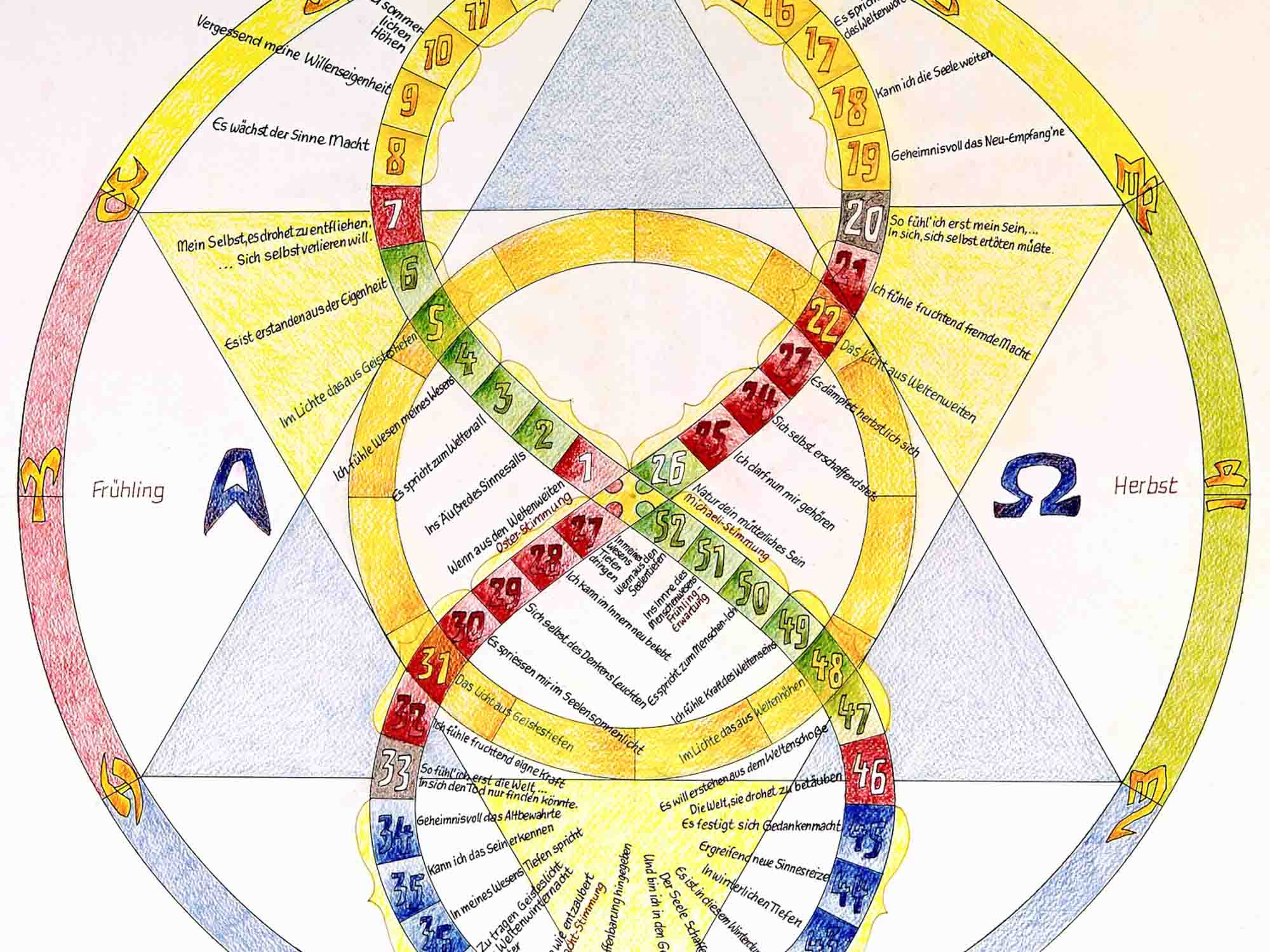The weekly verses of the anthroposophical Calendar of the Soul can be experienced “as artfully constructed miniatures that are lawfully related to each other in many ways and only together produce the total work-of-art.”1 Wolfgang Ritter has been working with the verses for 30 years and reports on his research here.
We have been working with the weekly verses for about 30 years at the Nuremberg branch. First, we wanted to understand their content; then, we looked for the relationship of the current verse to the mirror verse and to the counter verse;2 and, finally, we made observations in threes and fours.3 Why do we concern ourselves so intensively with the Calendar of the Soul? It accompanies us through the changing processes of the seasons and through the Christian festival year. Through it, we gain access to eternity and receive impulses to imprint ourselves upon eternity itself. “Living with these sayings leads to a spiritual empathy with the course of the year. In the process of immersion, unification takes place and world-knowledge becomes self-knowledge.”4 “Nature and human being spring from the same source, and so the soul experiences of human beings belong to the whole of creation. Indeed, to put it more pointedly, we can say that nature is longingly awaiting attention from the human soul.”5
Interpreting a Verse
Have you ever experienced the following? The current weekly verse is read at the branch meeting or a gathering—and you don’t understand a thing. That’s how I became familiar with the weekly verses. When the eurythmist Angelika Storch and I began a collaborative work about three decades ago, we placed the current weekly verse at the beginning of our studies of Rudolf Steiner’s basic books. We read the verse aloud and discussed the meaning to try and grasp its content. Lienhard Barz formulated interpretations for all 52 weekly verses. Here, as an example, is the verse of the 42nd week: “In this the shrouding gloom of winter / The soul feels ardently impelled / To manifest its innate strength, / To guide itself to realms of darkness, / Anticipating thus / Through warmth of heart the sense-world’s revelation.”6 The creative power of the soul wants to prove itself. The outside world is under the dominion of winter forces, the cold and the longer nights of darkness. In face of the outer darkening, a strong urge stirs in the soul to become active. How can the revelation of the senses be anticipated through intuition and warmth of heart? The plant world offers many starting points. The trees are still without foliage. Winter’s rest is only an intermediate step for a plant being. A good exercise is to vividly imagine, in detail, the gradual growth of the buds and their breaking open. The longing for spring expressed here gives the plant world spiritual help to then actually take the next steps. The soul forces of the human being unite with the still slumbering growth forces of nature. Nature and human being spring from the same source, so the soul experiences of human beings belong to the whole of creation.
Mirror Verse Observations
After several years of taking in the content of the weekly verses, we looked at the relationship of the current verse and the mirror verse. The mirror verse numbers can be found by writing the numbers for the 26 weeks of spring and summer on one line and below them the numbers of the 26 weeks of autumn and winter:
Spring and Summer
1 2 3 4 5 6 7 8 9 10 11 12 13 14 15 16 17 18 19 20 21 22 23 24 25 26
52 51 50 49 48 47 46 45 44 43 42 41 40 39 38 37 36 35 34 33 32 31 30 29 28 27
Autumn and Winter
Thus, the verses mirror each other on the horizontal axis. The verses that line up vertically are the current verse and its mirror. So verse 1 belongs to the mirror verse 52 and vice versa, verse 2 to the mirror verse 51 and vice versa, and so on. Verse and mirror verse are similar in structure and content and there are certainly more than one interpretation of their relationship.
If you add a consideration of the mirror verse to each weekly verse, every day for a whole year, you can develop additional forces in the soul—self-knowledge is strengthened. We can also feel how we perpetually live in the present, at the meeting point of the past and the future; we can feel how the external events arising from the past (evolution) are perpetually met by spiritual impulses from the future (involution). Michael Debus called this experience “experiential immersion in the supra-temporal double stream of time.”7 How we can intervene in life while meditating at the meeting point of past and future becomes especially clear in Lienhard Barz’s interpretation of verse 44: “The clear consciousness of one’s own spirituality, which was gained during the experience of winter time, continues to have an effect. Even more, the creative will of thinking expands the fragments of the sense impressions into a complete picture of a future state. This image of the future flows willfully from the depths of the soul into the outer world and thus supports the world forces that are working at that time.”
Here is an example from the 1st week—the spring, Easter mood: “When out of world-wide spaces / The sun speaks to the human mind, / And gladness from the depths of soul / Becomes, in seeing, one with light, / Then rising from the sheath of self, / Thoughts soar to distances of space / And dimly bind / The human being to the spirit’s life.” The mirror verse is from the 52nd week: “When from the depths of soul / The spirit turns to the life of worlds / And beauty wells from wide expanses, / Then out of heaven’s distances / Streams life-strength into human bodies, / Uniting by its mighty energy / The spirit’s being with our human life.” Both verses describe the alternating events of microcosm and macrocosm at Easter time. In verse 1, an impulse proceeds from the macrocosm (sun) and the human being responds. In verse 52, it is the other way around. Both cases come to a unification of human being and spirit being.
Verse and Counter Verse
The counter verse is the one exactly opposite in time to the current weekly verse. If the current weekly verse for the northern hemisphere is verse 1 (spring, Easter mood), the counter verse is the current verse for the southern hemisphere (27, autumn). For verse 2, the counter verse is verse 28. Regarding the effects we can achieve through counter verse meditation, Michael Debus writes: “Whoever wants to develop esoteric forces must have learned to unite polarities within themselves because, according to Rudolf Steiner, the esotericist never thinks or speaks without striking the corresponding counter pole. The summer experience is only a full reality when the winter experience resonates ‘at least quietly in the background.’ A completely new ‘global’ seasonal experience is thus predisposed.”8 It is not as easy to find the relations of verse and counter verse as it is to find the relations of verse and mirror verse because there is seldom a similar structure in the grammar or content. Only once do verse and counter verse begin similarly. Verse 5: “Within the light that out of spirit depths . . .” and counter verse 31: “The light from spirit depths . . . .” The mirror verses also sound similar. Verse 5 has mirror verse 48, which begins: “ Within the light that out of world-wide heights . . .”; verse 31 has mirror verse 22: “ The light from world-wide spaces . . . .” We experience this beautiful fourfold-sounding only if we bring all four verses into consciousness at the same time: if we meditate a verse quartet.

Here’s an example of the counter verses. In the 4th week: “I sense a kindred nature to my own: / Thus speaks perceptive feeling / As in the sun-illuminated world / It merges with the floods of light; / To thinking’s clarity / My feeling would give warmth / And firmly bind as one / The human being and the world.” The counter verse is in the 30th week: “There flourish in the sunlight of my soul / The ripened fruits of thinking; / To conscious self-assurance / The flow of feeling is transformed. / I can perceive now joyfully / The autumn’s spirit-waking: / The winter will arouse in me / The summer of the soul.” In both verses the main theme is the interplay of thinking and feeling in the outer and inner light—a ripened thinking, which Rudolf Steiner also called a “truth-thinking,” leads to “conscious self-assurance” because inner light, “sunlight of my soul,” permeates the soul. A “truth-feeling” (“I sense a kindred nature to my own” and “I can perceive now joyfully”) warms the clear thinking in verse 4. The neologism “sunlight of my soul” (Seelensonnenlicht) in verse 30 can also be interpreted as wisdom, and the “warmth” in verse 4 can be interpreted as love.
Groups of Three or Four
A further dimension of Rudolf Steiner’s wonderful composition of the weekly verses opens up when we investigate the relationships in the content of verses that belong together. Three successive verses have a special relationship to each other in terms of content. There are four verses (verse 7 in spring, verse 20 in summer, verse 33 in autumn, verse 46 in winter) that have unique positions in the course of the year. Relations to three preceding or three following verses can also be found.
For example, the 4th week, verse 4: “I sense a kindred nature to my own: / Thus speaks perceptive feeling / As in the sun-illuminated world / It merges with the floods of light; / To thinking’s clarity / My feeling would give warmth / And firmly bind as one / The human being and the world”; verse 5: “Within the light that out of spirit depths / Weaves germinating power into space / And manifests the gods’ creative work: / Within its shine, the soul’s true being / Is widened into worldwide life / And resurrected / From narrow selfhood’s inner power”; and verse 6: “There has arisen from its narrow limits / My self and finds itself / As revelation of all worlds / Within the sway of time and space; / The world, as archetype divine, / Displays to me at every turn / The truth of my own likeness.” An inner relationship, a significant threefold-step, is found: The I feels spirit being (verse 4); the soul appears resurrected in the light of the world (verse 5); risen from solitude, the human being experiences themselves as part of the divine revelation in the earthly world (verse 6).
Reflections on Verses Spanning Longer Periods of Time
It is also worthwhile to follow the unfolding expression of a series of verses over a longer period of time—even throughout the whole year. In spring, through the experience of blossoming and the light of the days becoming longer, the soul forces are stimulated in such a way that the suprasensible forces and powers which call forth and accompany natural events are able to be thought, felt, and willed by human beings. In autumn, with decreasing outer light and decreasing outer warmth, we can experience an inner ripening, that is, increasing inner light (clarity of thought) and increasing inner warmth (love). Clarity and love generate growing strength and growing will and thereby imprint themselves on the earthly and heavenly worlds. We receive support from the spiritual worlds. We are directly addressed four times:
- “In spirit sources seek expectantly / To find your spirit kinship” (Verse 13);
- “Imbue your spirit depths / With my wide world horizons / To find in future time myself in you” (Verse 17);
- “Imbue your labor’s aims / With my bright spirit light / To sacrifice yourself through me” (Verse 36);
- “I carry into you my life / From its enchanted bondage / And so attain my truest goal” (Verse 50).
Towards the end of the calendar of the soul year, there is a dialogue between the human being and the spirit being: “ I feel the force of cosmic life: / Thus speaks my clarity of thought” (verse 49), and: “Thus to the human ego speaks . . . / The joy of growth throughout the world: / I carry into you my life / From its enchanted bondage / And so attain my truest goal” (verse 50). We clearly experience how something eternal in the human being feels addressed by the annual (eternally!) repeating natural processes, how we carefully contemplate our own thoughts and feelings evoked by these processes, and how we resolve to do something.
The Verse Quartet
We received stimulus for contemplation of the fourfold-verse from Karl König’s work Anleitungen zum Seelenkalender: Der Anthroposophische Seelenkalender als innerer Wandlungsweg (Stuttgart 2009).9 Here, we let the current weekly verse, its mirror verse, its counter verse, and the counter-verse’s mirror verse all live within the soul at the same time. This results in 13 quartets of verses. Contemplating the verses in this way, we can look for a possible relationship between the four verses. Just as there are several interpretations, several relationships can be found. What can we achieve by contemplating the verse quartet? Our spatial and temporal awareness is sharpened, because with each verse quartet we bring into view both the northern and the southern hemispheres of the earth and all four seasons. As we already did in the mirror verses, we live into the “double stream of time,” because the past works on continuously and at the same time something continuously approaches us from the future. In addition, the soul experiences its own growth in the course of the year—through natural processes, through work on ourselves, and through our work in the world. The soul finds itself—the everyday self connects to the higher self that is not embodied. The soul achieves the connection to spiritual reality only through its own faculties (thinking, feeling, willing). It feels, cognizes, and wills itself as a part of world revelation, as a spirit being that is temporarily integrated into the natural processes. We can also characterize the value of the quartet observations in the following way: the weekly verses are a path to self-knowledge, self-awareness, and self-education. They clearly point out the connection of the soul with nature and the suprasensible world of being. We come to know how the soul grows when it works on itself, and how it is supported by nature and the cosmos. A way is shown to the World Spirit, to Christ; suprasensible perceptions (imagination, inspiration, intuition) are prepared; truth-thinking, truth-feeling, truth-willing are sown.
Let us look at a quartet of verses as an example. The verse of the 5th week is: “Within the light that out of spirit depths / Weaves germinating power into space / And manifests the gods’ creative work: / Within its shine, the soul’s true being / Is widened into worldwide life / And resurrected / From narrow selfhood’s inner power”; and the mirror verse in the 48th week: “Within the light that out of world-wide heights / Would stream with power toward the soul, / May certainty of cosmic thinking / Arise to solve the soul’s enigmas — / And focusing its mighty rays, / Awaken love in human hearts.” The counter to the 5th week is the 31st week: “The light from spirit depths / Strives to ray outwards, sun-imbued; / Transformed to forceful will of life / It shines into the senses’ dullness / To bring to birth the powers / Whereby creative forces, soul-impelled, / Shall ripen into human deeds.” And the mirror verse for the 31st week is the verse for the 22nd week: “The light from world-wide spaces / Works on within with living power; / Transformed to light of soul / It shines into the spirit depths / To bring to birth the fruits / Whereby out of the self of worlds / The human self in course of time shall ripen.” All four verses begin with “light.” This is unique in the 13 quartets of verses. In verse and counter verse, light flows from spirit depths (5 and 31), and in the mirror verses, from world widths (22) and world heights (48). The light flowing from the cosmos affects the human being. In the course of the year, it allows the fruits to ripen in the human being (summer, 22); it releases forces through the “forceful will of life,” (autumn, 31); it gives security and “awaken[s] love” (winter, 48); and, ultimately, it allows the expanded (“widened”) soul to appear in the light, “resurrected from narrow selfhood’s inner power” (spring, 5). Appearing in the “light” means: the soul is now perceived by spirit beings—it has “widened into worldwide life.”
Translation Joshua Kelberman
Footnotes
- Angela Fischer, Anthroposophie, no. 297 (Michaelmas 2021).
- Other English translations call these ‘corresponding verses’ and ‘opposite verses’.
- See Lienhard Barz, Wolfgang Ritter, Rudolf Steiner, Der anthroposophische Seelenkalender: Meditativer Umgang mit den Wochensprüchen. Gedankliche Aneignung, Spiegel- und Gegensprüche, Dreier- und Vierergruppen (The anthroposophical Calendar of the Soul: Working Meditatively with the Weekly Verses—Grasping the Conceptual Content, Mirror and Counter Sayings, Groups of Three and Four), 3rd exp. edn. (Borchen: Verlag Ch. Möllmann, 2022).
- Manfred Krüger, Die Seele im Jahreslauf: Versuch, den anthroposophischen Seelenkalender zu meditieren (The Soul in the Course of the Year: An Attempt to Meditate on the Anthroposophical Calendar of the Soul) (Basel: Die Pforte, 1992).
- See footnote 2, verse 42.
- Verse translations in this article are by Ruth and Hans Pusch.
- Michael Debus, Die Wochensprüche des anthroposophischen Seelenkalenders im Doppelstrom der Zeit beider Hemisphären (The Weekly Verses of the Anthroposophical Calendar of the Soul in the Double Stream of Time in Both Hemispheres), 3rd edn. (Dornach: Rudolf Steiner Verlag, 2011), 131.
- Ibid., 137.
- See Karl König, The Calendar of the Soul: A Commentary (Edinburgh: Floris Books, 2011) and An Inner Journey Through the Year: Soul Images and The Calendar of the Soul (Edinburgh: Floris Books, 2011).









